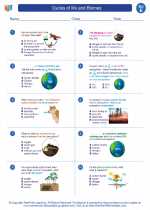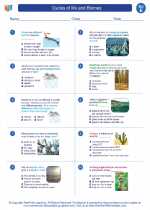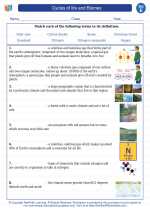Seasons
Seasons are the result of the Earth's axial tilt and its orbit around the Sun. The Earth's axis is tilted at an angle of approximately 23.5 degrees relative to its orbit around the Sun. This tilt causes different parts of the Earth to receive varying amounts of sunlight throughout the year, leading to the four distinct seasons: spring, summer, autumn, and winter.
Causes of Seasons:
- Earth's Axial Tilt: The Earth's axis is tilted, causing different parts of the Earth to receive varying amounts of sunlight at different times of the year.
- Orbit Around the Sun: As the Earth orbits the Sun, the angle at which sunlight strikes the Earth's surface changes, leading to different seasons in different hemispheres.
Effects of Seasons:
- Temperature Changes: Different seasons bring changes in temperature, with summer being the warmest and winter being the coldest.
- Daylight Hours: The length of daylight hours varies throughout the year, with longer days in summer and shorter days in winter.
- Nature and Wildlife: Seasons affect plant growth, animal behavior, and natural processes such as migration and hibernation.
Study Guide:
To understand the concept of seasons, consider the following questions:
- What causes the Earth's seasons?
- How does the Earth's axial tilt contribute to the changing seasons?
- Why do different hemispheres experience opposite seasons at the same time?
- What are the characteristic features of each season in terms of temperature, daylight hours, and natural phenomena?
- How do seasons impact human activities and cultures around the world?
Consider conducting experiments or observations to explore the effects of seasons on local flora, fauna, and weather patterns. Additionally, create visual aids such as diagrams or charts to illustrate the relationship between the Earth's tilt, its orbit, and the occurrence of seasons.
Understanding the concept of seasons is essential for comprehending the Earth's dynamic climate and its impact on the environment, ecosystems, and human societies.
[Seasons] Related Worksheets and Study Guides:
.◂Science Worksheets and Study Guides Fifth Grade. Cycles of life and Biomes

 Worksheet/Answer key
Worksheet/Answer key
 Worksheet/Answer key
Worksheet/Answer key
 Worksheet/Answer key
Worksheet/Answer key
 Worksheet/Answer key
Worksheet/Answer key
 Vocabulary/Answer key
Vocabulary/Answer key
 Vocabulary/Answer key
Vocabulary/Answer key
